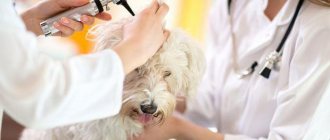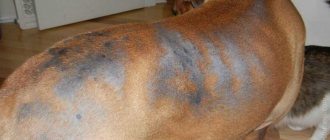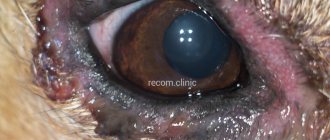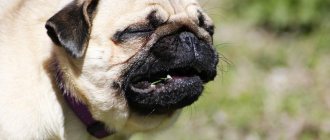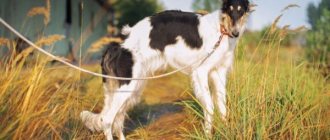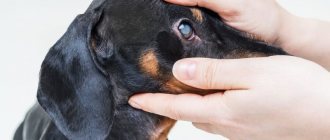The dog is lying in rotten meat
Many breeds of dogs, especially those with hunting blood, lie in carrion and rotten meat. Owners suffer from this habit, but it is almost impossible to correct the pet’s behavior. On every walk, the dog looks for fragrant garbage and immediately rolls out in it.
If you are the owner of an active, hunting dog that periodically smells of fish, we advise you to carefully monitor your pet during walks. Most likely, the pet finds dry fish peelings or the remains of other spoiled food, the smell of which is very intense.
Important! The dog falls out in the stench instinctively and does not see anything wrong with it, but such events are extremely dangerous for animals. Carrion and rotting food remains are a breeding ground for bacteria and parasites!
Malfunction of the paraanal glands
If the anal glands are blocked or malfunctioning, your dog may smell like raw or rotting fish. In Western countries, it is characterized as the smell of tuna.
The anal glands, or sacs, are cavities that are located on either side of a dog's anus. These sacs are constantly filled with a viscous liquid, which has a very specific, unpleasant odor. During defecation, the sacs are compressed and fluid comes out. This liquid helps the dog mark (mark) territory.
Emptying of the anal glands can occur involuntarily, for example when the dog is very frightened.
Blockage of the anal glands
The most common problem associated with malfunctioning paraanal glands is blockage. The reasons are varied, ranging from hereditary factors to improper feeding. Blockage occurs when the fluid becomes too thick and the anal sacs do not empty normally during bowel movements. This problem can be solved by cleaning and adjusting the diet.
When the anal glands are blocked, the dog experiences severe itching and sometimes pain. The pet's behavior changes; he constantly bites the fur in the tail area. It is because of the blockage of the anal glands (and not because of worms, as many people think) that dogs roll their butts on the ground or carpets.
Inflammation of the paraanal glands
If the blockage is not found or removed in a timely manner, the dog will find ways to scratch the anal area. Mechanical impact injures the delicate mucous membrane, which leads to infection and inflammation.
When the paraanal glands become inflamed, the following symptoms are observed:
- Containment of defecation.
- Painful bowel movement.
- Impurities of blood in stool.
- Inflammation of the anus, which is visible to the naked eye.
- Significant behavioral changes - the dog becomes agitated, sleeps poorly, and does not obey the owner.
- Aggression towards other animals, resulting in a feeling of vulnerability.
- Unpleasant odor from the dog.
The method of eliminating inflammation of the paraanal glands depends on the stage of the disease:
- At an early stage: cleaning, local care, disinfecting, healing ointments, diet correction.
- At the middle stage: transfer to a liquid diet, complex therapy, including antibiotics and anti-inflammatory drugs, local care.
- At a severe stage: aggressive complex therapy, surgery.
Causes of odor
The nature of the odor may vary. Conventionally, it can be divided into two large groups:
- Health status. The appearance of an odor may indicate a deterioration in the pet’s health or the presence of an illness.
- Animal care: sanitary and hygienic conditions and unbalanced nutrition.
The main causes of dog odor when health deteriorates
An unpleasant odor may appear in a dog for several reasons, indicating the pet’s health condition. Let's look at the main ones:
- From the mouth - with this symptom, first of all, it is necessary to check the animal’s teeth and gums for the presence of tartar. Mineralized plaque formed by food debris thickens over time, damages the gums and leads to inflammation (gingivitis), as well as caries; the dog’s mouth smells rotten.
- The metabolic disorder that is most often associated with a lack of insulin is diabetes mellitus. The disease is accompanied, in addition to thirst and skin defects, by the smell of sour fruit from the dog’s mouth.
- Malignant neoplasms. Old age of a dog is a risk of neoplasms in the pet’s body. Stomach cancer is signaled not only by constipation or diarrhea, but also by an unpleasant odor from the animal’s mouth.
- Dog ears, especially fold-eared breeds. The unpleasant odor occurs due to parasitism in the pet's ears by a mite, the causative agent of scabies - the otodectosis mite. In addition to the unpleasant stench, the disease gives the dog unbearable itching, accompanied by discharge from the ear canal and redness of the skin on the inner surface of the auricle.
- Blockage of the anal glands. When a fishy, herring “aroma” appears and the dog’s increased attention to the anus, you should pay attention to the condition of the glands that produce a specific secretion that is expelled during defecation. The anal glands are located at the junction of the rectum and anus. When the digestive system malfunctions, the glands are not emptied, congestion and inflammatory processes form, causing discomfort and pain to the dog.
- External skin condition, fungal diseases. The presence of lesions, scratches, peeling, rashes and other pathologies on the skin can cause not only restless behavior of the animal, but also be accompanied by a sour, rotten or fecal odor.
Prevention of malfunction of the paraanal glands
Although blockage may be considered a hereditary problem, following a few simple rules can help make the problem less of an issue:
- Balance your diet. Problems in the functioning of the anal glands most often appear due to a lack of fiber in food.
- Regularly check the formation of stool . Recurrent diarrhea or constipation may be the first step towards malfunction of the paraanal glands.
- Monitor the animal's physical activity and weight - almost all obese dogs suffer from blockage of the paraanal glands.
- Control your drinking regime - the secretion of the paraanal glands can thicken due to simple dehydration. Make sure your dog drinks enough water, especially when feeding dry food and in hot weather.
When an illness affects our pets, the responsibility falls entirely on our shoulders, because they cannot even tell us about it. What does a bad smell from the excretory system of a four-legged friend indicate?
There can be many reasons, and the consequences can be different. To eliminate an unpleasant odor, you must first find out its cause.
Where does the bad smell come from?
Urine smells strong
To find out why a dog's urine smells bad, you need to remember its biological functions. This is a liquid that removes salts, poison, drug metabolites, and decay products from the body.
- Violation of water-salt balance. It can be triggered not only by a large amount of seasonings and salt in the diet, but also by a lack of fluid. Urine becomes dark in color and has a pungent musty odor. In this case, you need to give your pet more water or other liquid, eliminate salt and seasonings from the diet. If your pet's condition worsens, you should consult a doctor for a more detailed diagnosis.
- Medicines . Pharmacological agents often disrupt metabolism, and their excipients are not absorbed by the body and are excreted unchanged in the urine. Most medications or nutritional supplements intended for dogs are easily excreted and only change the color of urine without affecting the smell. If you associate taking medications with the appearance of a bad odor, you need to stop taking them.
- Hormonal disbalance . The endocrine system also affects the quantity, quality (density, amount of eliminated toxins) and parameters of urine. The cause of the failure may be seasonal changes, mating games, or illness. In pregnant and lactating dogs, changes in smell and color are normal. If there are no obvious reasons for the change in odor, contact a veterinary clinic to confirm or refute the hormonal imbalance.
- Protein . Increased concentration of protein in the urine. This happens with various viral diseases and an excess of meat products in the diet. Along with the odor, small gray or white lumps appear in the urine. In this case, it is necessary to reduce the proportion of animal products in the diet.
- Kidney dysfunction . The kidneys regulate fluid exchange and the removal of foreign substances from the body. If the kidneys malfunction, they cannot cope with the task, swelling appears, or, on the contrary, the dog has a frequent urge to urinate and rapid loss of fluid.
Causes of pungent odor and possible diseases
There are really many reasons why a pet begins to emit an unpleasant odor. To identify the exact provoking factor, it is necessary to undergo a medical examination. The veterinarian will write out all the necessary directions.
Diseases of the genitourinary system
In a dog, the smell from under the tail may indicate developmental pathologies or diseases, inflammatory conditions of the genitourinary system. Most often, the smell is not fishy, but ammonia. In most cases, dogs are diagnosed with kidney failure. The pathology is accompanied by a slowdown in the elimination of waste products from the body, which poisons the tissues.
Among owners of Yorkshire terriers and other decorative breeds, a very common question is why a Yorkie's urine smells. The fact is that at the genetic level they have pathologies in the development or diseases of the genitourinary system.
Important! The pet must eat well and undergo regular medical examinations at a veterinary clinic.
Oral problems
As a rule, we are talking about tartar. The manifestation of such a symptom does not pose a threat to the health and life of the pet, but plaque on the teeth may not be so harmless. The destruction of tooth enamel, the formation of foci of infection, pain and difficult treatment can negatively affect the pet’s quality of life.
From under the fish's tail
The diagnostic principle is the same as in the previous paragraph. Both the stool itself and the glands located near the anus can smell. In females, during mating and mating, the glands can emit a specific odor that attracts males.
These reasons also explain why a dog scratches its butt on the floor :
- Poor nutrition . The basis of nutrition should be animal products, meat (especially raw meat), and offal. When carbohydrates (flour, sweets, porridge, potatoes) are added to the diet, the intestinal microflora undergoes changes that interfere with the digestion of food, which causes an unpleasant odor. Review your dog's diet and remember what changes you made to it.
- Metabolic disease . If the body is growing, metabolic changes occur constantly. The reasons could be anything, so there is no point in guessing. If, in addition to the smell, there are no other symptoms (pain, rashes, scabies), no measures need to be taken. If you see your dog's tail itching, go to the doctor!
- Poisoning . When the body is intoxicated, not only the stomach and intestines, but also the liver processes the foreign substance. Some enzymes that the body secretes to fight poison have an extremely unpleasant odor. If you begin to notice changes after defecation or a bout of vomiting, immediately give your dog activated charcoal or another absorbent and consult a doctor.
- Gastrointestinal diseases . With dysbiosis, constipation and other unpleasant ailments, food ferments in the stomach, causing gas, belching, an unpleasant odor and it begins to seem that the dog smells like fish from under its tail . Also, illnesses are accompanied by loss of appetite, weight loss, apathy, and lethargic mood. Another symptom will be that the dog’s bottom is itching, provided that this has not happened before.
- Lack of vitamins. If you have a rare breed whose natural habitat is far from yours, then its body will definitely be deficient in vitamins. Often there is not enough vitamin A, E, B6. This condition is also characterized by hair loss, peeling of the skin, seborrhea, and skin diseases. To solve the problem, a regular multivitamin complex is suitable.
You can treat the source of the odor with wet wipes (not alcohol-based).
It is not recommended to use deodorants or fragrances, as they can be harmful to your pet's health.
Good to know
- Rapid breathing in dogs (causes, pathogenesis, symptoms and signs, diagnosis, treatment and prevention). What to do if your pet has increased breathing? What types of breathing problems do dogs have?
- Why does my dog often vomit yellow or white foam? Distribution, causes, diagnosis and treatment of vomiting in dogs
- Why doesn't the dog eat anything? Causes, aspects of diagnosis, treatment and prevention. What to do if your dog won't eat food or food?
- Why does a dog scratch its ears and shake its head (reasons, range of diseases, diagnosis, treatment and prevention). Why does my dog constantly shake his ears?
- What is the reason why a dog constantly whines? How to solve this problem? When should you contact a veterinarian?
- Why is my dog breathing heavily and frequently? Physiology and pathophysiology of respiratory function in animals. First aid for a dog with difficulty breathing
- Why does a dog eat cat feces? The problem is serious and urgent. Find out how to correct this bad habit
- Why does a dog drink a lot of water? The main causes of thirst in dogs and tactics for animal owners. What should you do if your older dog starts drinking a lot of water?
- Discharge from the eyes in dogs (causes, pathogenesis, diagnosis, treatment, prevention). Why do my dog's eyes water or have discharge?
- Why does a young dog have bad breath? Have you considered the main causes of unpleasant mouth odor in dogs? An elderly dog has bad breath, what should I do?
- Why can a dog lose hair in patches or all over its body? What is the reason? What to do? How to treat hair problems in dogs?
- Why does my dog have diarrhea? Dog diarrhea (causes, pathogenesis, diagnosis, signs and symptoms, first aid, treatment and prevention)
- How to treat bartonellosis in dogs? Bartonella is a causative agent of septic processes in animals and humans. How to make a correct diagnosis? Symptoms of Bartonella in dogs, treatment, prevention and vaccination of Bartonella infection in dogs
- Canine bordetelosis (epizootology, distribution, pathogenesis, symptoms and signs, treatment and prevention). Bordetella in dogs (Bordetella bronchiseptica)
- How to treat adenovirus in dogs? How to make a correct diagnosis? Symptoms, treatment, prevention and vaccination for adenovirus infection in dogs
- Why is the dog lethargic and constantly lying down? Oppression of dogs (causes, pathogenesis, diagnosis, treatment). When should you seek veterinary help?
What to do?
If the smell from the butt is strong, then you need to master the ability to clean the anal glands. After cleaning, it would be good to give anti-allergy tablets (2-3 days), change the diet to a cleaner and healthier one for 2-3 weeks and try to take the animal to the toilet more often (3-4 times a day).
This topic is “smelly” and unpleasant, but very necessary for every responsible and loving owner. Don’t be lazy and for the sake of your pets, understand this issue:
Paraanal gland in a dog: How to clean
Many dogs never experience problems emptying the paraanal glands in their lives, which is why owners sometimes have no idea at all about their presence under the animal’s tail.
But such individuals more often belong to large breeds that live in the yard or have the opportunity to have an active lifestyle.
But in the case of small apartment dogs, the situation is sometimes quite the opposite. If you notice symptoms of clogged glands in your dog, they need to be cleaned.
How to clean a dog's anal glands? The procedure is certainly not the most pleasant, but it is technically simple and can be done by any owner.
How to properly trim a dog’s claws and ear hair: How to care for a dog’s fur at home: https://strazhchistoty.ru/cleanup/cleandogs/sherst-ukrashaet-sobaku.html
There are two ways to clean the glands:
- You should insert your index finger into the animal’s anus and feel the glandular formations on its sides, which are shaped like dense balls. Using light massage movements, you should empty the contents of the bags outward, the manipulation is carried out on both sides.
- Press the napkin to the anus and gently squeeze (press) the rectal area. This method may seem simpler in comparison with the first, however, it is not always possible to achieve the desired result with its help.
After emptying the glands, the area around the anus should be washed with detergent.
The procedure must be carried out with gloves and a mask, preferably in the bathroom or in the yard - the secretion may splash, and washing it off the carpet or furniture will be very problematic.
If we talk about the frequency of cleaning, this is decided individually - for one dog it is enough to clean the paraanal glands once every six months, for another this is not enough, and the manipulation is carried out monthly, or even more often.
Treating your dog yourself
Physiological processes in which discharge is normal
Estrus (estrus) is a stage of the reproductive cycle. This is a natural process that indicates that the female has reached puberty.
The timing of puberty often depends on the size of the breed. In miniature (small) dogs, the first heat begins earlier, in large dogs - a little later. The first heat occurs at 6-12 months, sometimes at 1.5 years. If the dog does not have it by the age of 2, then some kind of pathology is possible, and a doctor’s consultation is required. On average, the duration of estrus is 20-22 days. The exact cycle will be established in the female only after several heats. Dogs usually come into heat twice a year, and in some animals it happens once a year. If it occurs more often, there may be a risk of hormonal imbalances and a consultation with a specialist is also required.
The dog's reproductive cycle consists of 4 stages:
- Proestrus (pre-gesture) lasts approximately 7-10 days.
At this time, the first signs of estrus in the dog appear: blood flow to the genitals increases, the loop swells, and the first bloody discharge appears. But the dog is not ready for mating, since ovulation has not yet occurred. And her behavior is already changing. During this period, dogs can use panties for estrus.
- Estrus (actually estrus), sexual heat.
During this period, ovulation occurs. The cellular composition of the discharge changes, and in order to determine the dog’s readiness for mating, a smear is performed at the veterinary clinic to determine readiness (i.e., 7-10 days after the first signs of estrus). The discharge itself at this time may also be different for different dog breeds. In some individuals they may be practically absent, in others they become light pink. During the period of estrus, the bitch begins to allow male dogs to approach her: she raises her pelvis, tightens the loop, withdraws her tail and freezes.
- Metaestrus (end of estrus).
The reddish, light pink discharge disappears, the loop decreases in size. The female stops allowing male dogs to approach her. If pregnancy does not occur, the body returns to its normal state over time.
But dogs still have elevated levels of progesterone, and sometimes, regardless of whether fertilization has occurred or not, some bitches develop a false pregnancy, which most often goes away on its own and without consequences. But if suddenly there is a thickening of the mammary glands and a refusal to eat, you should consult a doctor. Drugs are prescribed to stop lactation and eliminate the symptoms of false pregnancy.
- Anestrus (sexual rest) is a period of absence of estrus.
The average duration is 100-150 days.
If estrus is too long (protracted), short, frequent or rare, you should consult a doctor.
Discharge that appears immediately before childbirth (it lasts 3-4 days or a little more) and after labor is also considered normal.
Discharge from a loop in a pregnant dog is a pathology!
That is, any discharge during pregnancy is considered abnormal and can be dangerous. Of course, very slight discharge is present during pregnancy, but it is so small that the owner should not notice it. If there is visible discharge, you need to consult a doctor and undergo an ultrasound. This will help you monitor the course of your pregnancy and find out the approximate number of fetuses.
24-48 hours before birth, sticky and thick discharge of a whitish or grayish color appears. They indicate that the so-called “plug” has come out and the birth process has begun. If you notice that the dog’s discharge before giving birth has a sharp putrid odor and a dark color (green, yellow, brown), if the animal’s body temperature has increased (after all, the temperature normally decreases before giving birth), the female should be immediately taken to the veterinarian and have an ultrasound performed.
After childbirth, the discharge in the first 2-3 days has a brownish color, then it gradually lightens and becomes transparent or with a slight pink tint. The duration of discharge varies from dog to dog. It depends on the size of the dog itself and the number of puppies. Usually, by the end of the maximum 2nd week of the postpartum period, the discharge becomes thinner and stops. That is, the involution of the uterus has occurred - its return to its prenatal size.
Subinvolution of the uterus is also possible - disruption or slowing of the reverse development of the uterus to normal (prenatal) sizes. It is rare and most often occurs in young dogs. Accompanied by prolonged (more than 3-4 weeks) sticky discharge, sometimes mixed with blood. This condition can lead to the development of endometritis (inflammation of the lining of the uterus), and with the addition of a bacterial infection and transition to a more dangerous process - pyometra (purulent inflammation of the uterus). If you experience any similar symptoms, you should consult a doctor.
Discharge in a dog after estrus
A dog may have discharge after estrus: spotting, odorless, transparent. Only in this case is this a variant of the norm. In any situation, you need to contact a veterinarian, since discharge with a strong odor, bloody or purulent can cause serious illnesses that need to be treated urgently.
During estrus, the dog is susceptible to numerous infections, since during this period of time, the body's immunity decreases as well as its natural defenses. Infections can easily be picked up during an active walk and when interacting with other animals.
It is especially worth paying attention if there is bleeding after estrus. In this case, we may be talking about a serious illness. So do not delay your visit to the veterinarian - the sooner treatment is started, the better for your pet.
Brown discharge after heat
The owner should be especially wary if the dog has brown discharge after estrus. To find out what is causing them, you need to show your pet to a veterinarian.
Our clinic employs experienced veterinarians who will examine your dog and take tests. Having worked in veterinary medicine for many years, our doctors are qualified specialists who love animals and always try to do everything in their power to make him feel better.
The modern veterinary laboratory is equipped with everything necessary, so that the test results will be ready on the day of your visit, which means the doctor will soon be able to make a diagnosis and begin treatment for your dog.
Prices for appointments in our network of veterinary clinics
| Name of veterinary services | Unit | Price, rub |
| ⭐ Initial appointment | 1 animal | 300 |
| ⭐ Repeated appointment | 1 animal | 200 |
| Appointment of ornamental, exotic animals, birds and reptiles with a general practitioner | 1 animal | 500 |
| Reception of decorative, exotic animals, birds and reptiles from a specialist doctor | 1 animal | 1000 |
| Initial appointment with a specialist | 1 animal | 1000 |
| Consultation without an animal | — | 500 |
| Consultation with a doctor based on test results | 1 PC. | 100 |


